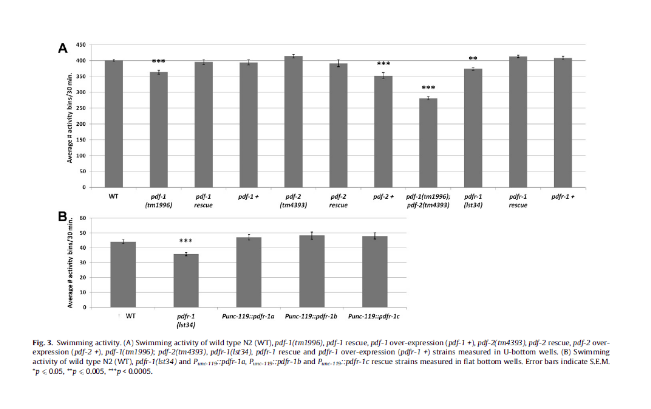
In Caenorhabditis elegans, pdfr-1 encodes three receptors of the secretin receptor family. These G protein-
coupled receptors are activated by three neuropeptides, pigment dispersing factors 1a, 1b and 2, which
are encoded by pdf-1 and pdf-2. We isolated a PDF receptor loss-of-function allele (lst34) by means of a
mutagenesis screen and show that the PDF signaling system is involved in locomotion and egg-laying. We
demonstrate that the pdfr-1 mutant phenocopies the defective locomotor behavior of the pdf-1 mutant
and that pdf-1 and pdf-2 behave antagonistically. All three PDF receptor splice variants are involved in
the regulation of locomotor behavior.
The WormMicrotracker was used to measure swimming activity. Ten staged L4 nematodes were picked to a well of a 96-well plate (U bottom or flat bottom) containing 100 ll of S Basal and 50 lM fluorode-oxyuridine (FUdR) to prevent self reproduction. After 5 h of recovery, the swimming activity of the worms was measured every minute and binned in 30-min blocks.

In figure 3A, we can observe how both pdf-1(tm1996) and pdfr-1(lst34) mutants are significantly less active compared to wild type C. elegans when swimming. Activity of pdf-1(tm1996) animals could be restored by re-introducing multiple copies of the pdf-1 promoter and gene, while over-expression of pdf-1 using the same genomic region does not result in any behavioral changes. The swimming activity of pdf-
1(tm1996);pdf-2(tm4393) double mutants is significantly reduced to approximately 2/3 of the wild type level. pdf-2(tm4393) mutants appear to have slightly elevated activity levels (103% compared to
wild type; p = 0.06) when swimming. The rescue strain shows no aberrant phenotype alterations and over-expression of pdf-2 results in 12% less activity. The diminished pdfr-1(lst34) swimming activity can be rescued by re-introducing copies of the pdfr-1 gene and its promoter and over-expression of this gene does not seem to influence activity levels.
In order to gain information on where and which specific PDF receptor splice variants are involved in locomotion, we generated a battery of splice variant-specific rescue strains. These express only one of the receptor splice variants in either body wall muscles (Phlh-1) or neurons (Punc-119). Expression of either Phlh-1::pdfr-1a, b or c did not result in restoration of activity (not shown). Pan-neuronal
expression of either pdfr-1a, b or c suffices to restore pdfr-1(lst34)
movement to wild type levels.
The experiments displayed in Fig. 3A were conducted in U-bottom 96-well plates while the
experiment displayed in Fig. 3B was conducted in a flat bottom 96- well plate. The swimming activity of worms in U-bottom wells is generally higher than in flat bottom wells since the shape of the well causes the worms to accumulate exactly in the path of the laser beam which detects activity. In flat bottom wells, the nematodes are more spread out and interfere less often with the laser beam. The decreased swimming activity of pdfr-1(lst34) is therefore more pronounced in flat bottom wells.
Mol Cell Endocrinol. 2012 Sep 25;361(1-2):232-40. doi: 10.1016/j.mce.2012.05.001. Epub 2012 May 11.
https://www.ncbi.nlm.nih.gov/pubmed/22579613
